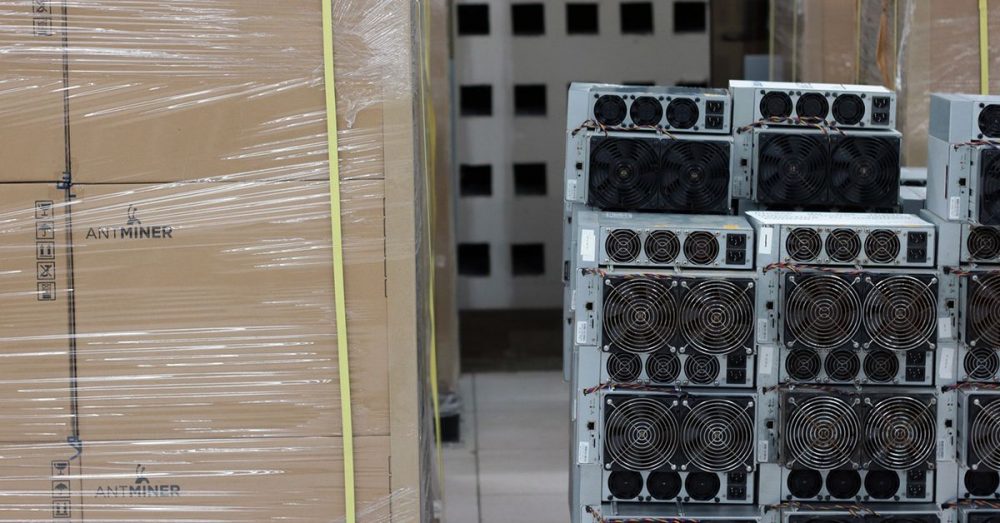Hundreds of thousands of brand new mining rigs that could be generating bitcoin (BTC) have never been used, further skewing the economics of cryptocurrency mining, a sector that has been hit hard by sinking prices for bitcoin and other tokens and by high energy costs.
Last year, miners struggled to buy enough rigs. Manufacturers couldn’t fulfill orders fast enough. Now, Matt Schultz, executive chairman of bitcoin miner CleanSpark (CLSK), figures 250,000 to 500,000 mining rigs are still sealed up in boxes in the U.S. alone, based on his conversations with analysts. Ethan Vera, chief operating officer of mining services firm Luxor Technologies, put the number at 276,000 worldwide in September.
Whatever the exact number is, this much is clear: The economics at the core of crypto are completely out of whack. More evidence of that came in September when Compute North, which runs data centers that host mining computers, filed for bankruptcy.
Read more: How Does Bitcoin Mining Work?
The reasons aren’t hard to follow: The price of bitcoin and other tokens have plunged dramatically, making the digital assets that miners earn less valuable. And miners’ costs have risen because of skyrocketing energy prices. It takes a lot of electricity to mine bitcoin, a process that involves specialized computers, known as mining rigs or machines, guessing the answer to an equation to receive bitcoin as a reward.
While many in the industry agree that rigs stuck in boxes are plentiful, there’s less agreement on exactly why they haven’t been installed yet. Some experts said there’s no room for them in data centers. Others said there’s plenty of space, but rigs are too expensive to run given the current market conditions.
Luxor’s Vera said that there is “limited rack space immediately available,” more than a year after China banned crypto mining, sending miners flocking to the U.S. and Kazakhstan. That has allowed hosting companies in countries that haven’t banned mining to boost their fees.
Core Scientific (CORZ) is the biggest miner in the world by hashrate, or the amount of computing power being directed toward a particular cryptocurrency’s blockchain. The company “has been able to revise its pricing structure for its hosting fee base rate as demand for racks has surged,” CEO Mike Levitt said in an interview. One person familiar with the matter said Core Scientific has increased its fee by 20% to 25% in recent months.
Hosting is a service that data centers provide to crypto miners so that customers can store their mining rigs and mine their preferred digital assets for a fee without having to build the accompanying infrastructure themselves. Core both self-mines bitcoin and hosts for other miners.
The impact of energy markets
But soaring energy prices and a plunging bitcoin price have made hosting machines unprofitable. As a result, less hosting services that are now profitable for the miners are available, making it harder for miners to find a cheap place to run their machines.
“There’s a difference between having no rack space and having no cheap rack space,” said Alex Martini, CEO of New York-based miner Blockfusion USA.
Now, there is rack space to plug the machines in, but hosting fees are too high because of high energy prices.
“We have 32 [megawatts] of empty space, and there are other sites that have [a total of] 400 MW of rack space,” but customers aren’t interested because energy rates are too high and the price of bitcoin is too low, Martini said.
“Power and hosting” aren’t constraints on the industry at the moment, but “the trick is” making the economics work given high energy prices, said Charlie Schumacher, vice president of corporate communications at Marathon Digital Holdings (MARA), which has machines hosted at Compute North’s facilities.
Before signing with Applied Blockchain (APLD) for 200 MW of capacity, Marathon vetted at least 30 hosting options, Schumacher said. “There’s more supply for hosting than there are people looking to fill it right now,” even though plenty of machines are sitting around, he said.
Martini said new mining machines can still sell for a premium, so miners aren’t unpacking them unless they can mine crypto for a profit.
Meanwhile, Schumacher said some miners are cutting their fees to attract new customers.
“Over the more recent months, we have noticed that hosting price quotes have started to decline. We suspect that it will continue for the rest of the year,” said Rob Chang, CEO and founder of bitcoin miner Gryphon Digital Mining.
Vera agreed that the requirement for cheap power “slows down the development of infrastructure,” and so overall supply is limited.
Manufacturer discounts
Despite the oversupply, manufacturers are still making mining rigs, albeit at a discounted selling price.
In late August, Bitmain, the world’s largest mining rig maker, unveiled a coupon program, offering up to 30% discounts to large customers that bought machines in the summer of 2021. In September, it announced an approximately 30% discount on the Antminer S19 Pro 100 terahash model.
Some miners, including CleanSpark, Core Scientific and Marathon, have exercised a clause in their contracts – called “price protection” – that allows them to adjust the prices paid for the new rigs.
Contracts for mining rigs usually require a deposit, with the rest of the funds paid in installments as shipments leave the manufacturer. For big contracts, manufacturers included this “price protection” clause, which means that before every shipment, the two parties can evaluate the market price and adjust the payments.
Xmei Lin, head of marketing at Bitmain told CoinDesk that the price protection feature offers “bulk order customers protection against market price volatility.” If “cryptocurrency market prices decrease,” Bitmain will reduce the price of purchased mining machines, based on monthly price analysis, Lin said.
The other two big equipment manufacturers, MicroBT and Canaan, declined to comment on this story.
Still, given the capital constraints in the market, there is less demand for mining rigs now, and miners have even had to cancel orders they raised capital for last year, Schumacher said.
Whether this continues, “depends on the price of bitcoin,” he said.
Read more: Crypto Miners Face Margin Calls, Defaults as Debt Comes Due in Bear Market







